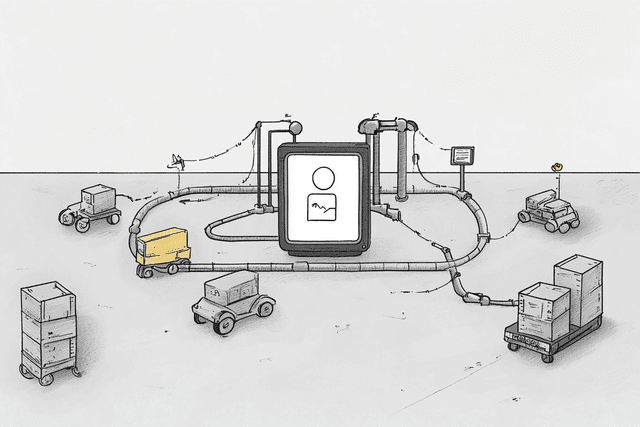In the fast-paced world of software development, delivering high-quality applications quickly and efficiently is paramount. To stay competitive, organizations must adopt practices that streamline the development process and ensure the rapid delivery of reliable software.
Enter CI/CD—a powerful methodology that has revolutionized the way development teams build, test, and deploy their applications. By embracing CI/CD, companies can accelerate their time to market, improve code quality, and foster better collaboration between development and operations teams.
In this comprehensive guide, we'll dive deep into the world of CI/CD, exploring its key concepts, benefits, and best practices. Whether you're a seasoned developer or just starting your journey into the realm of software development, understanding CI/CD is essential for success in today's digital landscape.
What is CI/CD?
CI/CD stands for Continuous Integration and Continuous Delivery/Deployment—a software development methodology that emphasizes automating the build, test, and deployment processes. The goal of CI/CD is to enable the rapid, reliable delivery of high-quality software by streamlining the development lifecycle.
Continuous Integration (CI) is the practice of developers regularly merging their code changes into a central repository. With each code commit, an automated build and unit testing process is triggered, allowing teams to detect and address integration issues early in the development cycle. Tools like Jenkins, GitLab CI, or GitHub Actions can automate the CI process, ensuring that code changes are continuously integrated and tested.
Continuous Delivery/Deployment (CD) takes the automation a step further by extending the CI process with automated release processes. Continuous Delivery ensures that the software is always in a releasable state, ready to be deployed to production at any time. Continuous Deployment, on the other hand, automatically releases changes that pass the CI/CD pipeline directly to production without manual intervention. Tools like Spinnaker, ArgoCD, or AWS CodeDeploy can help automate the CD process, enabling the rapid delivery of new features and bug fixes.
By implementing CI/CD, development teams can:
Accelerate time to market: Automating repetitive tasks and reducing manual effort allows teams to deliver software faster and more frequently.
Improve code quality: Frequent integration and automated testing help catch and fix issues early, resulting in higher-quality code.
Reduce deployment risks: Automated testing and deployment processes lower the risk of introducing errors or breaking changes into production.
Enhance collaboration: CI/CD fosters better collaboration between development and operations teams, breaking down silos and promoting a culture of shared responsibility.
Increase customer satisfaction: By delivering value to customers faster and more reliably, organizations can improve customer satisfaction and gain a competitive edge.
Implementing CI/CD requires a combination of tools, processes, and best practices. Let's explore some of the key components and best practices that make up a successful CI/CD pipeline.
Benefits of Implementing CI/CD
Modern software development teams face increasing pressure to deliver new features and updates at an unprecedented pace. CI/CD practices revolutionize development workflows by automating the integration and deployment processes, allowing for a seamless transition from code creation to production deployment. This automation minimizes manual interventions, reduces potential errors, and lets teams concentrate on innovation and delivering value.
The impact of CI/CD extends beyond just speed—it fundamentally changes how teams approach software quality. With a continuous feedback loop enabled by automated testing, teams can identify defects early in the development cycle. This early detection not only reduces the cost of fixing bugs but also enhances the overall stability of applications, ensuring a more reliable user experience.
DevOps teams benefit significantly from the improved transparency and control that CI/CD provides. Real-time insights into code changes facilitate rapid issue identification, while standardized deployment processes ensure uniformity across various environments. This consistency results in more predictable software releases and allows teams to sustain high development velocity without compromising on system integrity.
CI/CD drives a cultural shift towards greater collaboration and efficiency within development environments. By fostering a unified approach to the software delivery lifecycle, development and operations teams align more closely, sharing accountability and insights. This synergy dismantles traditional barriers, encourages knowledge exchange, and leads to informed architectural decisions that balance development and operational priorities.
Furthermore, CI/CD offers tangible business advantages through cost efficiency and better resource allocation. As automation reduces the need for manual oversight, developers can focus on complex problem-solving and innovation. The ability to deploy smaller, frequent updates mitigates the risks associated with large-scale releases, enabling swift responses to market trends and security challenges.
Key Components of a CI/CD Pipeline
A robust CI/CD pipeline consists of various interconnected stages that enable a seamless software delivery process. It starts with version control, where developers consistently integrate their code changes into a shared repository. This ensures that the codebase remains current and manageable, providing a solid foundation for further stages in the pipeline.
Build and Test Automation
In the build stage, code is compiled and packaged into deployable artifacts. This phase also involves running a series of automated checks to ensure code quality and security. Automated tests, including unit, integration, and end-to-end tests, are executed to validate functionality and catch defects early, providing rapid feedback to developers and maintaining code integrity.
Deployment Environments
The pipeline incorporates multiple environments—such as development, testing, and production—to simulate real-world conditions and ensure code reliability. Each environment serves a specific purpose, allowing teams to conduct thorough testing and validation at various stages before code reaches production, thereby minimizing the risk of defects and ensuring a smooth deployment process.
Monitoring and Feedback
A well-designed pipeline includes robust monitoring tools that track the health and performance of applications in real-time. These tools provide valuable insights and feedback, enabling teams to quickly identify and address issues, optimize processes, and ensure that deployments meet performance standards. Automated rollback mechanisms can be triggered if performance metrics fall below acceptable levels, maintaining system stability and reliability.
Best Practices for Implementing CI/CD
Implementing CI/CD effectively involves a strategic approach to development workflows and tool integration. By leveraging distributed systems for version control, teams can achieve seamless collaboration and maintain a robust codebase. Embracing a streamlined development strategy—centered on frequent integration—keeps the codebase stable and encourages efficient issue resolution.
Infrastructure and Configuration Management
Adopting Infrastructure as Code (IaC) enables teams to manage their environments with precision and consistency. By treating infrastructure configurations as version-controlled entities, teams can replicate environments reliably and automate scaling processes. This structured approach prevents configuration drift and enhances system reliability.
Testing Strategy
A layered testing approach is crucial to ensuring software quality. Unit tests provide granular validation, while integration tests confirm that components work together harmoniously. Performance and stress tests assess system behavior under various conditions, ensuring resilience and reliability in real-world scenarios.
Security and Compliance
Security should be an integral part of every stage of the CI/CD pipeline. Static analysis tools help detect vulnerabilities in the code, while runtime security checks ensure applications operate securely in production environments. Incorporating regular security audits and compliance checks ensures adherence to industry standards and mitigates potential risks.
Dependency Management
Proper management of external dependencies is key to maintaining application stability. By utilizing dependency management tools, teams can ensure consistent versioning and timely updates. Automated vulnerability scanning of dependencies further secures the software supply chain, preventing security breaches.
Environment Parity
Achieving environment parity involves standardizing configurations across development, testing, and production stages. Utilizing containerization technologies allows applications to run consistently across various environments, reducing discrepancies and deployment issues. Centralized configuration management ensures that environment-specific settings are consistently applied.
Monitoring and Observability
Implementing comprehensive monitoring solutions provides valuable insights into application behavior. Real-time metrics and logs enable teams to pinpoint issues quickly and optimize performance. Observability tools enhance understanding of system dynamics and user interactions, facilitating informed decision-making and continuous improvement.
Deployment Strategies
Advanced deployment techniques, such as rolling updates or A/B testing, minimize disruption during the release process. By gradually implementing changes, teams can monitor their impact and swiftly address any arising issues. These strategies enhance deployment confidence and ensure stable, user-friendly releases.
Implementing CI/CD with Modern Tools
Harnessing the capabilities of cutting-edge CI/CD platforms is essential for organizations aiming to streamline their software delivery processes. These cloud-native solutions provide robust infrastructure that supports complex deployment needs while ensuring ease of use and scalability.
Advanced Workflow Management
Modern CI/CD platforms enable intricate workflow orchestration, facilitating seamless integration, testing, and deployment. They allow for tasks to be executed concurrently, thereby reducing overall build times. By leveraging distributed systems, developers can efficiently manage resources, ensuring that the CI/CD pipeline operates smoothly even under heavy load.
Integrated Code Analysis
To ensure only high-quality code reaches production, contemporary CI/CD tools incorporate extensive code analysis functionalities. They offer built-in mechanisms for conducting security checks and assessing code quality, providing developers with immediate feedback on potential issues. This integration helps maintain high standards throughout the development lifecycle and supports continuous improvement.
Adaptability and Extensions
With an emphasis on flexibility, these platforms support extensive customization, allowing teams to tailor their CI/CD pipelines to specific needs. This adaptability extends to incorporating specialized testing frameworks and security tools, which can be seamlessly integrated into existing workflows. The result is a cohesive development environment that supports diverse project requirements.
Dynamic Resource Allocation
Leveraging containerization and cloud infrastructure, modern CI/CD solutions provide dynamic resource management that scales according to demand. This capability ensures that build environments remain responsive and efficient, regardless of project complexity. Automated resource allocation optimizes performance and cost-effectiveness, enabling teams to maintain high throughput and reliability.
Overcoming Challenges in CI/CD Adoption
Embracing CI/CD often necessitates tackling both technical and organizational challenges. A common obstacle is the reluctance to shift from traditional workflows to automated processes. To counter this, it's crucial to illustrate how CI/CD complements existing roles by streamlining routine tasks, thus allowing teams to dedicate more time to strategic initiatives.
Enhancing Team Expertise
A robust training regimen is essential for successful CI/CD adoption. Developers and operations personnel should gain comprehensive exposure to both the technical aspects and strategic impact of CI/CD. Interactive sessions and collaborative projects can bridge knowledge gaps, encouraging teams to work in unison and share insights, thereby fostering a culture of continuous learning.
Gradual Rollout
Implementing CI/CD in stages enables organizations to adjust and refine their approach without overwhelming the teams. Beginning with a pilot project or a single application allows for the development of tailored processes. This phased strategy helps teams to:
Identify Bottlenecks: Tackle specific challenges in the workflow before scaling
Evaluate Tools: Assess how well selected tools perform in controlled environments
Document Insights: Capture learnings to inform broader CI/CD implementation
Continuous Improvement
Regular reviews of pipeline metrics are essential to maintain CI/CD effectiveness as the organization scales. By analyzing data such as deployment frequency and test coverage, teams can pinpoint areas for enhancement. Establishing benchmarks and iterating on them ensures the CI/CD pipeline evolves to meet growing organizational demands.
Managing System Integrity
Rapid delivery cycles can introduce complexities that need careful management to maintain system integrity. By setting clear guidelines for code reviews and testing standards, teams can prevent the buildup of technical debt. Allocating dedicated time for maintenance tasks and improvement efforts ensures the CI/CD pipeline remains robust and responsive to the needs of the organization.
As you embark on your CI/CD journey, remember that the key to success lies in embracing automation, fostering collaboration, and continuously improving your processes. By adopting the best practices and leveraging the right tools, you can unlock the true potential of CI/CD and transform the way you deliver software.
Ready to take your CI/CD implementation to the next level? Check out our docs to dive deeper into the world of continuous integration and delivery. We're here to support you every step of the way, providing the insights and guidance you need to build a robust, efficient, and scalable CI/CD pipeline.






